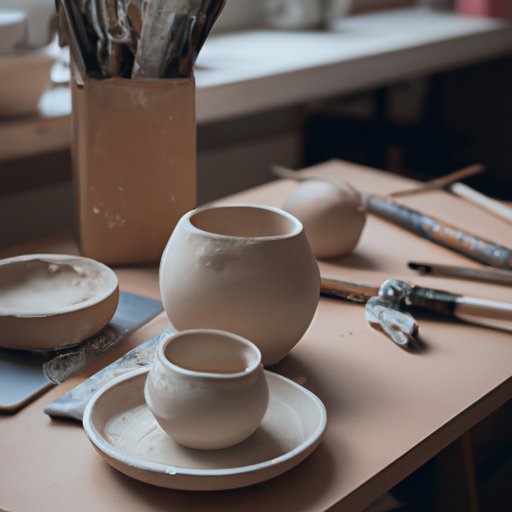Introduction
Pottery is an art form that has been around for centuries. It involves the shaping of clay into a variety of forms, from bowls and cups to sculptures and jewelry. It’s a great way to express yourself creatively and can be extremely rewarding. Starting pottery at home is a great way to get into the craft, as it allows you to work on your projects in the comfort of your own home.
The benefits of starting pottery at home are many. You have complete control over the environment and tools you use, so you can create pieces exactly to your liking. Plus, it’s a great way to relax and de-stress after a long day. And best of all, you don’t need to spend a fortune on supplies – all you need is a few basic materials and some time.

Identify the Necessary Supplies for Home Pottery
Before you can begin your pottery journey, you need to make sure you have all the necessary supplies. The most important supplies are the types of clay and glazes you’ll be using. There are many different types of clay available, from earthenware to porcelain, so you should do some research to determine which type is best suited for your project. Glazes are also important as they provide a protective coating for your finished piece.
In addition to clay and glazes, you’ll also need tools and supplies to help you create your pottery. This includes items such as sponges, rolling pins, brushes, and ribbons. You should also consider investing in a pottery wheel if you plan on doing wheel throwing. This will allow you to create more complex pieces and save time.

Research Different Types of Clay and Glaze
Once you’ve gathered your supplies, it’s time to do some research on the different types of clay and glaze available. Each type of clay and glaze has its own unique properties, so it’s important to understand these before making a purchase. For instance, stoneware clay is strong and durable, while porcelain is lightweight but fragile. Likewise, different glazes offer different finishes, from glossy to matte.
It’s also important to understand the firing temperatures for each type of clay and glaze. Different clays require different temperatures for firing, so make sure you read the instructions carefully before firing your pieces. The same goes for glazes – different glazes require different temperatures for firing, so make sure you read the instructions carefully before applying the glaze.

Learn Basic Pottery Techniques and Skills
Now it’s time to get creative! Before you can start creating beautiful pieces of pottery, you need to learn the basics. This includes understanding the different techniques used in pottery, such as wheel throwing and hand building. Wheel throwing involves using a pottery wheel to shape the clay into a desired form, while hand building involves using your hands and simple tools to manipulate the clay into the desired shape.
You’ll also need to learn about glazing techniques. Different glazes require different application methods, so it’s important to understand how to apply the glaze correctly. Once you’ve mastered the basics, you can experiment with new techniques and designs to create unique pieces.
Set Up a Home Pottery Studio
Once you have the basics down, it’s time to set up a home pottery studio. The first step is to choose a location in your home that has plenty of space and natural light. You should also consider investing in a pottery wheel, kiln, and other equipment, such as wedging tables and clay extruders. Additionally, you’ll need to ensure that your workspace is well-ventilated and safe.
It’s also important to take safety precautions when working with clay and glazes. Make sure you wear protective clothing, such as gloves and eye protection, when handling the materials. Additionally, you should keep your workspace clean and free from dust and debris to prevent accidents.
Practice, Experiment, and Have Fun!
Now that you’ve got everything set up, it’s time to get practicing! Here are a few tips to help you get started:
- Start with simple projects, such as cups and bowls, until you get the hang of things.
- Take your time and enjoy the process – pottery is not a race.
- Don’t be afraid to experiment – try different glazes, tools, and techniques.
- Be patient – perfecting your skills takes time.
Starting pottery at home can be a fun and rewarding experience. With patience and practice, you can create beautiful pieces of art that you can be proud of. So go ahead and give it a try – you might just surprise yourself!
Conclusion
Starting pottery at home doesn’t have to be intimidating. All you need is the right supplies, a bit of research, and some practice. With these steps, you’ll be able to create beautiful pieces of pottery in no time.
(Note: Is this article not meeting your expectations? Do you have knowledge or insights to share? Unlock new opportunities and expand your reach by joining our authors team. Click Registration to join us and share your expertise with our readers.)
